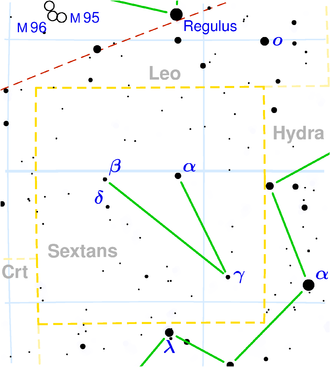NGC 3023
| Galaxy NGC 3023 |
|
|---|---|

|
|
| SDSS recording | |
| AladinLite | |
| Constellation | sextant |
|
Position equinox : J2000.0 , epoch : J2000.0 |
|
| Right ascension | 09 h 49 m 52.6 s |
| declination | + 00 ° 37 ′ 05 ″ |
| Appearance | |
| Morphological type | SAB (s) c |
| Brightness (visual) | 12.3 mag |
| Brightness (B-band) | 13.0 likes |
| Angular expansion | 3 ′ × 1.4 ′ |
| Position angle | 70 ° |
| Surface brightness | 13.7 mag / arcmin² |
| Physical data | |
| Affiliation |
NGC 2967 group LGG 182 |
| Redshift | 0.006268 ± 0.000023 |
| Radial velocity | 1879 ± 7 km / s |
|
Stroke distance v rad / H 0 |
(77 ± 6) · 10 6 ly (23.7 ± 1.7) Mpc |
| history | |
| discovery | Édouard Stephan |
| Discovery date | March 10, 1880 |
| Catalog names | |
| NGC 3023 • UGC 5269 • PGC 28272 • CGCG 007-043 • MCG + 00-25-022 • IRAS 09472 + 0051 • 2MASX J09495263 + 0037043 • VV 620 N01 • NVSS J094952 + 003704 • KPG 216B • LDCE 671 NED004 | |
NGC 3023 is a merging bar-spiral galaxy of the Hubble-type SBc / P in the constellation Sextant in the southern sky . It is an estimated 77 million light years away from the Milky Way and about 70,000 light years in diameter. Together with NGC 3018 , it forms the gravitationally bound galaxy pair KPG 216 .
In the same area of the sky are u. a. the galaxies NGC 3015 , NGC 3042 , IC 566 .
The object was discovered on March 10, 1880 by Édouard Stephan .
